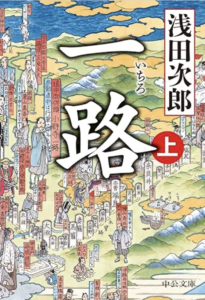Life Tips & Miscellaneous Travel and History Zen Philosophy and History Art and Sport Navigation of this blog
Daimyo Gyoretsu (daimyo’s procession)
The Daimyo Gyoretsu, featured in historical novels such as Ichiro by Jiro Asada, which has also been made into a film, refers to the processions taken by feudal lords when they go out with their attendants on official business, and the typical form of procession is that between Edo and their territories during the Sankin Koshiro.

Originally, the daimyo procession was a form of warlike and military movement similar to a wartime march (e.g. swords could be larger than normal length), but as the peace of the Edo period continued, it gradually transformed into a large-scale and flamboyant display of the authority and prestige of the feudal lords. Some believe that the Tokugawa Shogunate had a political intention to restrain the economic power of the feudal lords by forcing them to spend money on feudal lord processions, but the original purpose was to show obedience to the Shogun, and there was a tendency on the part of the feudal lords to make the processions large-scale to show off their loyalty, clan power and authority. The procession was also a way of showing loyalty, clan power and authority on the part of the feudal lords.

The number of people in a daimyo’s procession for official shogunate business, such as the daimyo’s visit to the shogunate, was set by the shogunate and varied slightly from period to period, but according to a regulation from 1721 (Kyoho 6), a 100,000 koku daimyo was expected to have 10 mounted warriors, 80 foot soldiers and 140 to 150 foot soldiers (jinzoku). In order to protect their own appearance and show off the power of their domains, the feudal lords tended to bring with them a larger number of attendants than was required by the shogunate, and their processions tended to be extravagantly dressed.
For example, records show that the Kaga clan, the largest of the feudal lords of the Edo period with 1.02 million koku, had 4,000 men at its peak, used three different routes to adjust for the weather and other feudal lords, took about 4,000 retainers and spent about 6,000 ryo (500 million yen in current terms) each way. As those monies were dropped en route each year, in a sense, like public works projects today, the economic effect on the whole of Japan was immeasurable.

Thus, the long and flamboyant daimyo processions became a real financial burden for the daimyo families, gradually squeezing the clan’s finances, which in turn transferred the money to the townspeople, as described in “Ukiyo-e and new prints – the good old things in the art world” and fireworks, as described in “The History of Fireworks and the Fireworks, Tamaya and Kagiya of Edo.”
In the historical novel “Orewa 10,000 goku” by Takashi Chino, a weak feudal lord struggles to pay for a daimyo’s procession while struggling with debts to a merchant.

The attendants of the daimyo’s procession included warriors on horseback and on foot, foot soldiers with guns and bows, chugen (samurai servants) with toolboxes, spear-bearers, doctors and others who served close to the daimyo. They also took care with their clothing, and each feudal lord had his own distinctive icons, such as keiyari (spears with hair), horse marks and family crests.

One third of the attendants in these daimyo processions were actually temporary part-time workers, called toshi hiyato, who were not samurai but labourers dispatched by a mediator called rokugumi tippet wholesaler. These were mainly employed as baggage carriers, but there were exceptions: tall, beautiful men and women were chosen to carry the hair spears that were particularly prominent in the Daimyo procession, and they were reportedly paid more than twice the daily wage of the baggage carriers, which was around 15,000 yen in modern money.
The procession of the feudal lords, which was carried out while making ends meet and hiring day labourers, is also depicted in the film Chōkōsoku!

When a procession of feudal lords passed along a road, the common people present were supposed to give way, but the roadside levelling often seen in period dramas was only used in the processions of the Shoguns and the three Tokugawa families, the Owari and Kishu clans. The call of “Shimo shita-, shita-” was not used in the processions of ordinary feudal lords, but was basically “kata-yore-, kata-yore-” or “yokero, yokero”, while the common people could simply move aside and watch the procession from a standing position. It is said that the feudal lords’ procession was a kind of entertainment for the common people, and that the clans also made their feudal lords’ processions more colourful to meet the expectations of the common people.


コメント